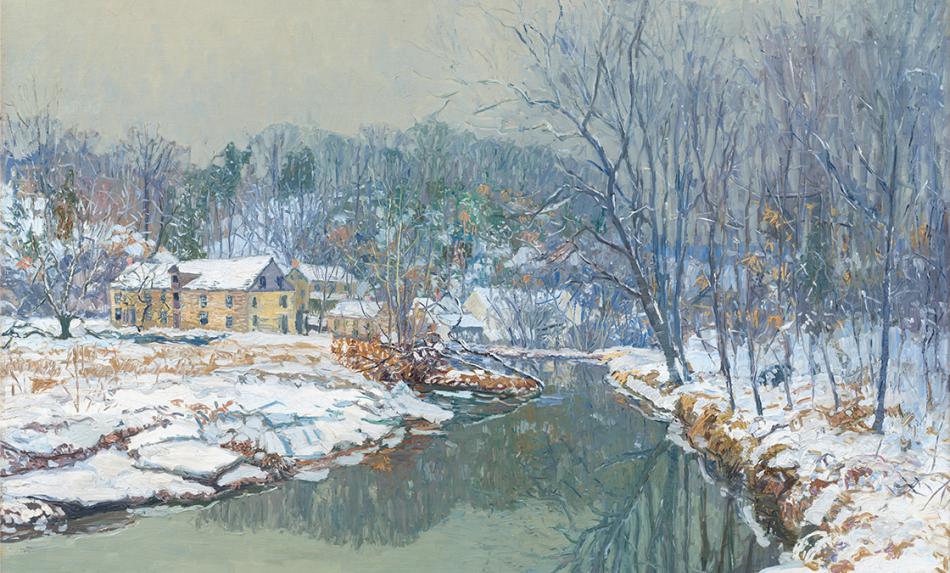Santa Trinità dei Monti in the Snow
1825/1830
André Giroux
Painter, French, 1801 - 1879

Giroux first studied painting under his father in his native Paris, and began to exhibit landscapes at the Salon in 1819. He entered the École des Beaux-Arts in 1821 and won the Prix de Rome for historical landscape in 1825. This coveted prize took him to the Académie de France in Rome, where he studied until 1830. Many a French artist made the trip to Rome during this period, and Giroux numbered among his friends there such innovative young landscape painters as Jean-Baptiste-Camille Corot, Caruelle d'Aligny, Edouard Bertin, and Léon Fleury. Although idealized, historical landscapes won official academic favor, in practice Giroux and his contemporaries had a passion for working out-of-doors. They sought to capture their experience of nature as immediately as possible by painting in oils, usually on prepared paper, in the open air. A sense of immediacy is often conveyed by the sketchiness of these open-air studies, which were usually made quite quickly. Sometimes, however, these artists completed such works in the studio, bringing them to a greater degree of finish. Giroux and his compatriots went on painting expeditions together, both in Rome and beyond its walls, into the surrounding campagna. In 1831 Giroux submitted a group of such oil studies made in Italy--probably the more finished type, rather than freely executed sketches--for exhibition at the Salon in Paris, where they won him a gold medal. This indicates a growing public and official acceptance, immediately following the Revolution of 1830, of a more naturalistic aesthetic.
Santissima Trinità dei Monti, in the Snow was most likely painted from a window, rather than strictly in the open air: after all, such weather was hardly conducive for working outdoors! The view is taken from the north side of the Villa Medici, the seat of the Académie de France on the Pincian Hill in Rome, looking toward the famous church and convent of the title; the convent's snow-covered kitchen garden is in the foreground. We can speculate that the view was made from the artist's own window while he was a student at the Villa Medici. The date of 1827-1828, suggested by an old pencil inscription on the stretcher of the canvas, is consistent with Giroux's residence there. Beyond the church of Santissima Trinità dei Monti, the Palazzo Quirinale blocks the horizon; the obelisk to the right in front of the church marks the top of the Spanish Steps. Giroux has captured the steely gray light of a cold winter's day, and brilliantly combines a sharp sense of topographical accuracy with a lively, sketchy, painterly touch.
More information on this painting can be found in the Gallery publication French Paintings of the Nineteenth Century, Part I: Before Impressionism, which is available as a free PDF https://www.nga.gov/content/dam/ngaweb/research/publications/pdfs/french-paintings-nineteenth-century.pdf
(Text by Philip Conisbee, published in the National Galery of Art exhibition catalogue, Art for the Nation, 2000)

West Building Main Floor, Gallery 91
Artwork overview
-
Medium
oil on paper on canvas
-
Credit Line
-
Dimensions
overall: 22 x 30 cm (8 11/16 x 11 13/16 in.)
framed: 34.6 x 42.1 x 3.8 cm (13 5/8 x 16 9/16 x 1 1/2 in.) -
Accession Number
1997.65.1
More About this Artwork

Video: Wintertime Art Screensaver
Enjoy relaxing music and a series of wintertime landscapes from our collection.
Artwork history & notes
Provenance
Private collection, France. (John Lishawa, London). (Didier Aaron Gallery, Inc., New York); purchased 2 June 1997 by NGA.
Associated Names
Exhibition History
2000
Art for the Nation: Collecting for a New Century, National Gallery of Art, Washington, D.C., 2000-2001, unnumbered catalogue, repro.
2020
True to Nature: Open-Air Painting in Europe, 1780–1870, National Gallery of Art, Washington; Fondation Custodia, Collection Frits Lugt, Paris; The Fitzwilliam Museum, Cambridge, 2020 - 2022, no. 91, repro.
Bibliography
2000
Eitner, Lorenz. French Paintings of the Nineteenth Century, Part I: Before Impressionism. The Collections of the National Gallery of Art Systematic Catalogue. Washington, D.C., 2000: 269-272, color repro.
2004
Hand, John Oliver. National Gallery of Art: Master Paintings from the Collection. Washington and New York, 2004: 358, no. 293, color repro.
Inscriptions
on edge of paper tape folded over top stretcher bar, reverse, in ink: A. Giroux 1825 [or 1829?]
Wikidata ID
Q20185369

